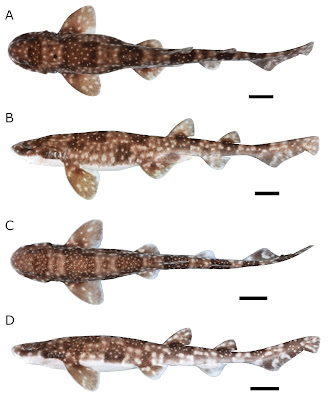 |
| Scyliorhinus hachijoensis Ito, Fujii, Nohara & Tanaka, 2022 |
Abstract
A new species of catshark genus Scyliorhinus, S. hachijoensis sp. nov., is described for the islands of Mikurajima, Hachijojima, and Torishima in southeastern Japan. Scyliorhinus hachijoensis has clasper hooks, which is a common feature in males of the most closely related species (S. torazame), but is distinguished by its coloration (presence of dark spots), the height of its anal fin (higher than the caudal peduncle), and the shape of pectoral and pelvic fins, and dermal denticles. Molecular data also corroborates the new species as a distinct and monophyletic taxon by nucleotide sequence analysis of three mitochondrial DNA regions.
Key words: Scyliorhinus torazame, Scyliorhinus hachijoensis sp. nov., Chondrichthyes, morphology
Scyliorhinus hachijoensis sp. nov.
New English name: Cinder cloudy catshark;
New Japanese name: Fukami-torazame.
Diagnosis: A species of Scyliorhinus distinguished by its anterior nasal flaps not reaching the upper lip (vs. flaps reaching upper lip, and sometimes covering it, in S. canicula, S. cervigoni, S. comoroensis, S. duhamelii, S. garmani and S. stellaris); nasoral grooves absent and posterior nasal flaps situated posterior to excurrent apertures (vs. nasoral grooves prexents and posterior nasal flaps laterally situated in S. canicula and S. duhamelii); mouth length less than half of mouth width (vs. mouth length more than or equal half of mouth width except in S. torazame and S. ugoi); anal fin height more than caudal peduncle height (vs. less than caudal peduncle height in S.boa, S. duhamelii, S. torazame and S. torrei), and greater than or equal to half of mouth width (vs. less than half of mouth width in S. boa, S. capensis, S. duhamelii, S. haeckelii, S. hesperius, S.meadi, S. torazame, S. torrei and S. ugoi); saddles darker than the background color (vs. inconspicuous or absent in S. boa, S. cabofriensis, S. cervigoni, S. duhamelii, S. garmani and S. torrei, and dark lines in S. retifer); body grayish brown to dark brown with well-defined light spots and small dark spots (vs. spots absent in S. retifer, yellow to golden spots in S. capensis, light spots absent in S. cervigoni, S. garmani, S. meadi and S. retifer, and dark spots absent in S. capensis, S. comoroensis, S. hesperius, S. meadi, S. torazame and S. torrei); light spots spiracle-sized or larger (vs. predominantly smaller than spiracles in S. boa, S. cabofriensis, S. canicula, S. duhamelii, S. stellaris and S. ugoi); dark spots smaller than spiracles (vs. predominantly larger than spiracles in S. cervigoni, S. duhamelii, S. garmani, S. haeckelii and S. stellaris); number of monospondylous vertebrae 34–36 (vs. counts higher except in S. duhamelii, S. torazame and S. torrei); clasper with hooks (vs. absent in all other species except S. torazame); accessory terminal cartilage present (vs. absent in S. cabofriensis, S. cervigoni, S. comoroensis, S. duhamelii, S. haeckelii, S. stellaris, S. torrei and S. ugoi); egg case surface with irregularities (vs. smooth in all other species).
Distribution: This species was recorded from the waters around the Izu Islands, Japan (Fig. 7). All specimens were captured by longline fishing for Splendid alfonsino, at depths of ca. 100–200 m around Mikurajima Island, ca. 200–400 m around Hachijojima Island, and ca. 500–600 m around Torishima Island.
Etymology: The species name “hachijoensis” refers to the species’ main collection area, Hachijojima Island. The English name is derived from “Cinderella”, because the dark spots on the body surface are similar to black ashes “cinder”. The Japanese name “Fukami” means “deep sea”.
 |
| Egg cases of (A, B) Scyliorhinus hachijoensis and (C, D) S. torazame. (A, C) Dorsal view, scale bar = 10 mm. (B, D) Close-up of surface. Scale bar = 2 mm. |
Nanami Ito, Miho Fujii, Kenji Nohara and Sho Tanaka. 2022. Scyliorhinus hachijoensis, A New Species of Catshark from the Izu Islands, Japan (Carcharhiniformes: Scyliorhinidae). Zootaxa. 5092(3); 331-349. DOI: 10.11646/zootaxa.5092.3.5


